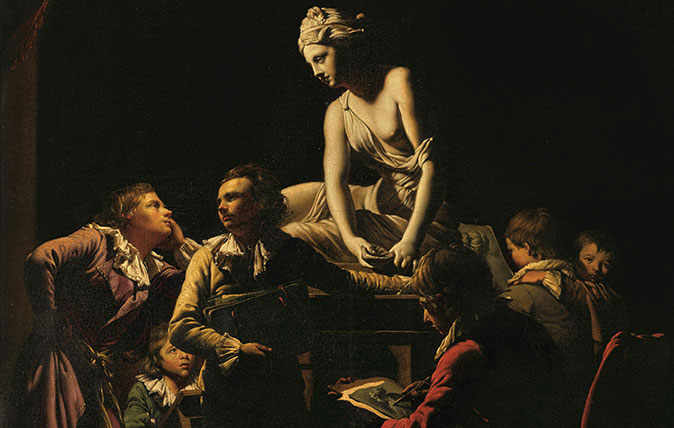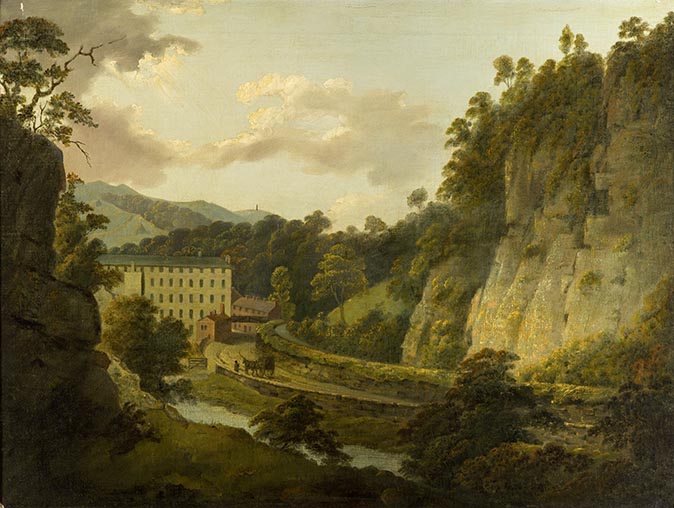In Focus: The candelight paintings which are the highlight of the career of Joseph Wright of Derby
The ‘candlelight’ paintings by Joseph Wright of Derby represent the high point of the career of one of our great painters. As one of them now leaves the country, Emma Crichton-Miller revisits the artist’s early groundbreaking achievements – and in particular An Academy by Lamplight.



On December 6, 2017, Sotheby’s auction house in London offered for sale Joseph Wright of Derby’s ambitious and striking 1769 painting An Academy by Lamplight.
A group of boys, aged perhaps 6–18, in distinctive frill-collared shirts, are gathered in a mysterious, dark space around the cast or marble copy of an antique Greek sculpture. Their faces are lit by warm lamplight, which emanates from behind a draped red curtain in the upper-left-hand corner of the painting and also seems to touch into life the marble flesh of the statue, the Borghese Nymph with a Shell, now in the Louvre.
Some boys are sketching intently, one stares adoringly at the nymph and one young child seems to gaze out of the picture altogether.
It is an intensely realised, intimate scene that both draws on Old Master paintings and addresses the immediate painterly and intellectual concerns of Wright’s day: such as the teaching of art, a love of strong contrasts of light and dark and the excited rediscovery of Antiquity during the Enlightenment.
The estimate at the recent sale was £2.5 million to £3.5 million, reflecting the fact that this significant ‘candlelight’ painting, from the period of Wright’s most daring and original canvases when he was seeking to establish himself as a young artist, was the last of his major works still in private hands. Last publicly exhibited a decade ago, it had hung in Somerleyton Hall, Suffolk, since the 19th century. (Another, more elaborate, version of the composition exists: painted in 1770 and acquired by Paul Mellon in 1964, is in the collection of the Yale Center for British Art, New Haven, USA.)
Strong interest from a number of bidders finally left three to battle the price to a record £7,263,700 (including fees), the winning bid coming from an overseas buyer. This price doubled the previous record for a painting by Wright – the $7,208,000 paid for the heroic full-length Portrait of Robert Shore Milnes, which sold at Sotheby’s New York in January 2007.
In May of this year, one last effort was made to keep the painting in Britain. A temporary export bar was imposed by Ministers in recognition of the cultural importance of the beautiful An Academy by Lamplight. But by the end of July the bar had lapsed, with none of the interested parties – above all, Tate Britain and Derby Museum and Art Gallery (the latter the keeper of the world’s largest collection of works by Wright) – able to raise the funds to keep the painting in the UK.
Exquisite houses, the beauty of Nature, and how to get the most from your life, straight to your inbox.
It is certainly a great loss, but what both the sale and the subsequent efforts to retain the painting here have brought into focus is Wright’s brilliance at his best, highlighting the qualities of intellect and imagination that make him, as the expert advisor to the Secretary of State phrased it, ‘one of the most important, and most distinctive British painters of the 18th century’.
That the artist added ‘of Derby’ to his name is indicative of the pride he felt in his home town and its important place within a rapidly industrialising nation, but it also suggests a parochialism that is altogether at odds with the wide range of his interests and the scale of his achievement.
Wright of Derby’s reputation rests on a handful of wholly original and groundbreaking paintings that he created in an eight-year period, starting when he was only 30 years old. Born in 1734, the third son of John Wright, attorney and town clerk of Derby, and his wife, Hannah Brookes, he attended grammar school before beginning his formal art education at the age of 17 in the London studio of the fashionable portrait painter Thomas Hudson, with whom Sir Joshua Reynolds had also studied.
On his return to Derby, Wright quickly established a reputation for candid and lively portraits, partly achieved through the relaxed and unusual poses and props he used. Already, however, his interest in light was evident: a 1760–62 genre painting, A girl reading a letter by Candlelight, with a Young Man peering over her shoulder, shows him experimenting with the dramatic effects of candlelight, which accentuates the curves and hollows of both figures’ faces and makes of the transparent paper behind which the candle lies a glowing mystery. We are as intrigued as the young man to know what the letter contains.
In 1765, for his first exhibition in London, Wright produced Three Persons Viewing the Gladiator by Candlelight, the first of the great ‘Candlelights’. Wright was by no means the first painter to be drawn to nocturnal, candlelit scenes. The French 17th-century painter Georges de la Tour had made a specialism of them, as had many artists from the Low Countries and Dutch Republic. With Wright and this painting, however, the genre takes a new direction: the candlelight in the velvety darkness has become a metaphor for the Enlightenment.
The following year, 1766, Wright was back in London showing A Philosopher giving that Lecture on the Orrery, in which a lamp is put in place of the Sun. One of his most famous paintings, this is a daringly composed imaginary scene inspired by the many lectures given by itinerant scientists to lay men, women and children all over England. Wright himself may well have attended the course of scientific lectures given in Derby by the Scottish astronomer James Ferguson, who would have used a rather smaller orrery than the one portrayed to demonstrate the workings of the Copernican solar system.
In the Orrery and the equally audacious canvas An Experiment on a Bird in the Air Pump, exhibited in London in 1768, Wright captures not only the visual poetry and drama of these highly contemporary scenes, painted with extraordinary verve and precision, but also reflects in the faces of the participants the profound impact of these scientific ideas upon their most deeply held religious and philosophical beliefs. Nothing like them had been seen before. As a contemporary reviewer commented in 1768: ‘Mr Wright, of Derby, is a very great and uncommon genius, in a peculiar way.’
Wright went on to create famous images in other genres, particularly with his landscapes. And a number of scholars have recently revisited the late literary paintings, including the wonderfully stirring Antigonus in the Storm, inspired by Shakespeare’s play The Winter’s Tale.
Yet however curious and appealing his later works, it is those crucial candlelight paintings of his early thirties that express Wright’s true quality. In these few canvases, each a compelling fusion of visual drama and intellectual argument, he achieved a radical originality. The loss of the Somerleyton painting from Britain is a deep blow. Let us hope we will now be more be more vigilant about other masterpieces.
A longer version of this article appeared in Country Life September 12 2018.

Country Life is unlike any other magazine: the only glossy weekly on the newsstand and the only magazine that has been guest-edited by His Majesty The King not once, but twice. It is a celebration of modern rural life and all its diverse joys and pleasures — that was first published in Queen Victoria's Diamond Jubilee year. Our eclectic mixture of witty and informative content — from the most up-to-date property news and commentary and a coveted glimpse inside some of the UK's best houses and gardens, to gardening, the arts and interior design, written by experts in their field — still cannot be found in print or online, anywhere else.
